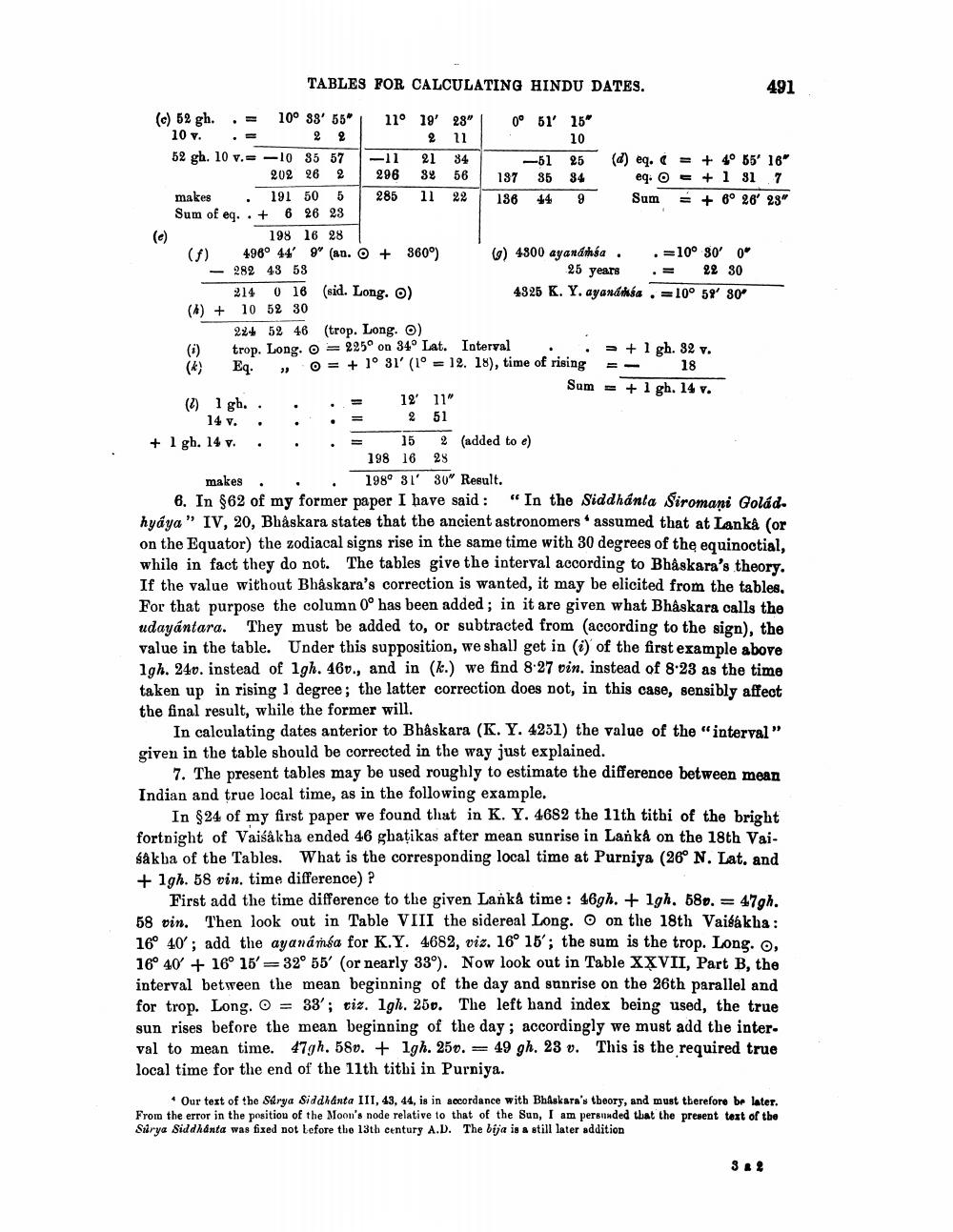________________
10
TABLES POR CALCULATING HINDU DATES.
491 (c) 52 gh.. = 10° 38' 55" 11° 19' 28" | 0° 51' 15" 10 v. .=
2
2 11 52 gh. 10 v.- -10 85 57 -11 21 84 -61 25 (d) eq. ( = + 4° 55' 16"
202 26 2 296 34 56 137 85 84 eq. O = +1 817 makes 191 50 5 285 11 22136 44 9 Sum = + 8° 26' 23" Sum of eq. . + 626 23
198 16 28 (f) 498° 44' gran. O + 360°) () 4800 ayanáthsa. - 282 43 53
25 years . = 22 30 214 0 16 (sid. Long. o)
4325 K. Y. ayanátusa . = 10° 59' 30" (1) + 10 52 30
224 52 46 (trop. Long. O) (i) trop. Long. o 225o on 34° Lat. Interval
= + 1 gh. 32 v. (4) Eq. = + 1° 31' (1° = 12. 18), time of rising E - 18
Sum = + 1 gh. 14 v. () lgh. . . . = 12' 11"
14 v. . . . = 2 51 + 1 gb. 14 v. . . . = 152 (added to e)
198 16 28 makes . . . 198° 31' 30" Result. 6. In $62 of my former paper I have said: "In the Siddhanta Siromani Golád. hyâya” IV, 20, Bhaskara states that the ancient astronomers • assumed that at Lanka (or on the Equator) the zodiacal signs rise in the same time with 30 degrees of the equinoctial, while in fact they do not. The tables give the interval according to Bhaskara's theory. If the value without Bhaskara's correction is wanted, it may be elicited from the tables, For that purpose the column 0° has been added ; in it are given what Bhaskara calls the udavántara. They must be added to, or subtracted from (according to the sign), the value in the table. Under this supposition, we shall get in () of the first example above 1gh. 240. instead of lgh. 46v., and in (k.) we find 827 vin. instead of 8.23 as the time taken up in rising 1 degree; the latter correction does not, in this case, sensibly affect the final result, while the former will
In calculating dates anterior to Bhaskara (K. Y. 4251) the value of the “interval" given in the table should be corrected in the way just explained.
7. The present tables may be used roughly to estimate the difference between mean Indian and true local time, as in the following example.
In $24 of my first paper we found that in K. Y. 4682 the 11th tithi of the bright fortnight of Vaisakha ended 46 ghatikas after mean sunrise in Lanká on the 18th Vaisakba of the Tables. What is the corresponding local time at Purniya (26° N. Lat. and + 1gh. 58 vin, time difference) ?
First add the time difference to the given Lanka time: 46gh. + lgh. 580. = 47gh. 58 vin. Then look out in Table VIII the sidereal Long. on the 18th Vaisakha: 16° 40'; add the ayanamsa for K.Y. 4682, viz. 16° 15'; the sum is the trop. Long. O, 16° 40 + 16° 15' = 32° 55' (or nearly 33°). Now look out in Table XXVII, Part B, the interval between the mean beginning of the day and sunrise on the 26th parallel and for trop. Long. = 38'; riz. lgh. 250. The left hand index being used, the true sun rises before the mean beginning of the day; accordingly we must add the interval to mean time. 47gh. 580. + 1gh. 250. = 49 gh. 23 v. This is the required true local time for the end of the 11th tithi in Purniya.
Our text of the Sarya Siddhanta III, 43, 44, is in accordance with Bhaskara's theory, and must therefore br later. From the error in the position of the Moon's node relative to that of the Sun, I am persuaded that the present text of the Surya Siddhanta was fixed not before the 13th century A.D. The bija is a still later addition
3.2




